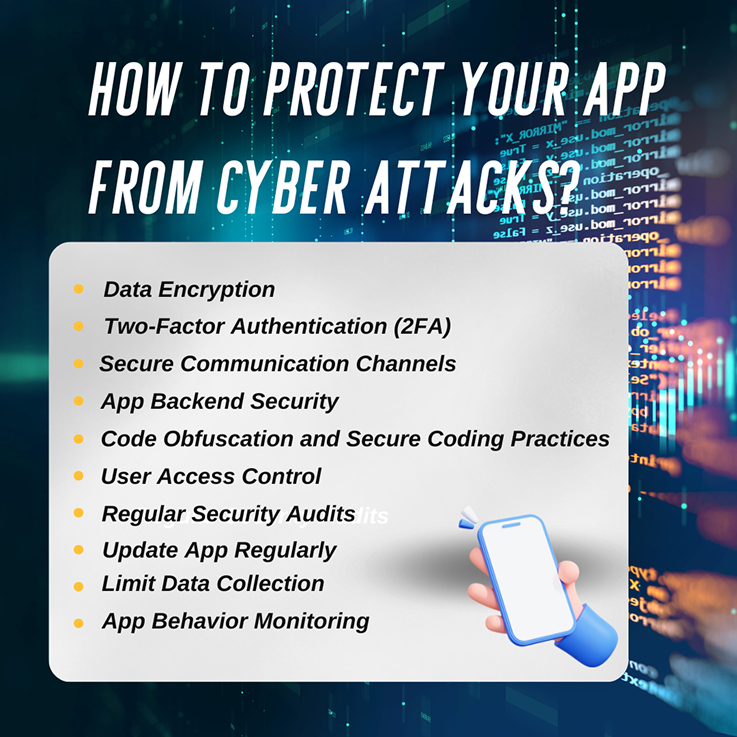
How to Build a Client-Attracting Website for Your Nu...
Having a strong online presence is no ...

In today’s digital landscape, ensuring the security of mobile apps is essential. We use apps for almost everything— banking, shopping, or even just staying connected. But with this convenience comes a growing risk. Hackers are constantly looking for ways to steal sensitive information or find weaknesses in apps to exploit. For businesses, this is a serious concern. A secure app isn’t just about following regulations; it’s about protecting your users, earning their trust, and keeping your business safe.
A single security breach can damage your reputation and cost more than just money, it can cost you your users’ confidence. Cyber threats are always evolving, which makes staying ahead of them even more important. Taking steps to secure your app now isn’t just a good idea, it’s a must to ensure long-term success and peace of mind for both you and your users.
In this blog, we’ll look at simple and effective ways to protect your app from cyber attacks, including app security best practices, encryption techniques, and tips for preventing hacking in apps.
Securing your mobile app is crucial to protect user data, maintain trust, and prevent cyber attacks. Here are some essential security measures to help safeguard your app:

App encryption techniques like end-to-end encryption are essential to protect data during transmission, keeping it secure from the moment it leaves the user’s device until it reaches your secure app backend servers. Additionally, encrypting data at rest, whether in databases, cloud storage, or on the device, further strengthens your app data protection.
This approach not only prevents data breaches but also minimizes risks if your storage systems are ever compromised. Investing in encryption isn’t just a technical measure; it’s an essential step in following app security best practices to prevent cyberattacks in apps and maintain user trust.
To secure your mobile app, you should combine data encryption with two-factor authentication for apps. 2FA adds a powerful extra layer of security by requiring users to verify their identity with two steps: something they know (like a password) and something they have (like a one-time code sent to their phone). This method significantly reduces the risk of unauthorized access.
Even if a hacker manages to steal a user’s password, they won’t be able to bypass the second verification step. By implementing 2FA, you not only protect user accounts but also show your commitment to preventing data breaches in apps.
Using secure communication channels is a key step in protecting your app from cyber attacks. Always use HTTPS (Hypertext Transfer Protocol Secure) to encrypt the data sent between the app and its server.
Because HTTPS ensures that any information exchanged, such as login credentials or personal data, is transmitted securely. Without HTTPS, attackers can easily intercept data through “man-in-the-middle” attacks, which allows them to alter or steal the information being transferred.
In addition to encrypting data, HTTPS also verifies the authenticity of the website the app is connecting to, reducing the risk of phishing attacks.
Your app’s backend is like its control center, it’s where important data and processes are stored and managed. That’s why keeping your mobile app backend servers secure is so important. Start simply by setting up firewalls and intrusion detection systems (IDS).
These act like guards, watching all the traffic and stopping anything suspicious. Next, always update your servers. Regular updates fix weaknesses that hackers might try to use against you. Then, add strict access controls.
Only the right people or apps should be able to access sensitive data or systems. It’s like giving out special passes, you wouldn’t let just anyone into a VIP area, right? When your backend is secure, you’re not just protecting private data, you’re safeguarding your entire app. Stay alert, stay secure!
To protect your app from cyber attacks, you need to secure the app’s code. Code obfuscation is a technique that makes it harder for hackers to reverse-engineer the app and identify potential vulnerabilities. By obfuscating the code, attackers are unable to easily understand its structure, making it more challenging to exploit weaknesses. In addition to obfuscation, always follow secure coding practices.
This includes things like validating all input to prevent injection attacks (e.g., SQL injection), using parameterized queries, avoiding hardcoded credentials, and preventing cross-site scripting (XSS). Secure coding helps minimize the number of vulnerabilities in the code that could be exploited by attackers.
User access control is essential for limiting exposure to sensitive data and reducing the impact of potential attacks. Implement role-based access control (RBAC) to ensure users only have access to the parts of the app necessary for their role or function.
Let’s take an example, an administrator might have full access to the app’s settings, while regular users should only have access to their own profiles and general features.
When you limit access like this helps reduce the chances of unauthorized access and minimizes the damage a hacker can do if they break into an account. On top of that, set up account lockouts after too many failed login attempts to stop brute-force attacks in their tracks.

Regular security audits and penetration testing are must-haves when it comes to protecting your app from cyber attacks. Security audits help find vulnerabilities in your app that hackers could use to break in. Penetration testing, on the other hand, is like a practice drill where you simulate real-world attacks to see how well your app’s defenses hold up.
By regularly testing your app, you can catch and fix weaknesses early before they become serious problems. Also, these audits don’t just boost security, they also help ensure you’re handling user data properly and staying compliant with privacy laws. It’s a proactive way to protect your app, your users, and your reputation.
To stay ahead of cyber threats, it’s crucial to update your app regularly. This includes patching known vulnerabilities in the app’s code, updating third-party libraries and frameworks, and installing the latest security fixes for the underlying operating system and server software.
Hackers often target apps that haven’t been updated in a while because they may be running on outdated, vulnerable code. Setting up an automatic update system or providing regular updates to users will help ensure your app stays secure and reduce the likelihood of an attack.
To reduce risk, you need to collect the data your app needs. Storing less sensitive information means there’s less to worry about if something goes wrong. you should open up with your users about what data you’re collecting and how it’s being used, and avoid storing sensitive info unless it’s necessary for the app’s features.
The more data you store, the higher the risk, both for your users and your app. Collecting too much data makes your app a bigger target for hackers. By keeping things simple and only storing what’s essential, you limit the damage if a breach ever happens.
This will keep things safer and show your users that you care about their privacy. Keep it secure by only holding onto what’s needed.
It’s important to monitor your app’s behavior to catch any signs of a cyber attack early. When you keep an eye on how your app is performing and stay ahead of the competition in the real world and how users are interacting with it, you can spot any unusual activity. This could include things like unauthorized access attempts, sudden increases in traffic, or strange data requests.
You can set up automated alerts to notify you of any suspicious actions. This way, you can respond quickly to potential threats and stop damage before it gets worse. Real-time monitoring is crucial for detecting and preventing attacks before they escalate, helping you keep your app and users safe. Regularly tracking app behavior helps you stay one step ahead and address security issues as soon as they arise.
In today’s world, protecting your app from cyber attacks isn’t just about keeping data secure, it’s about earning and maintaining your users’ trust. By implementing the strategies mentioned above, you can significantly reduce the risk of cyber threats. These steps will help you secure your mobile app and protect sensitive user data. But if you’re looking for assistance in implementing these strategies, connect with Nascenture for expert support. Our team specializes in preventing app cyber attacks and ensuring a safe, reliable experience for your users.